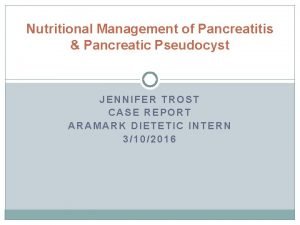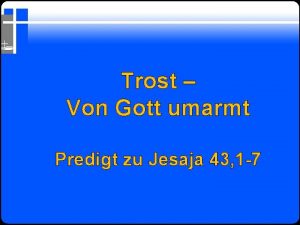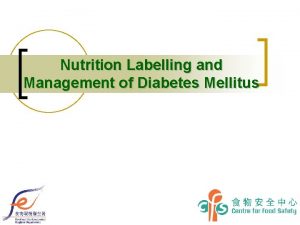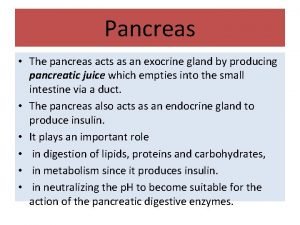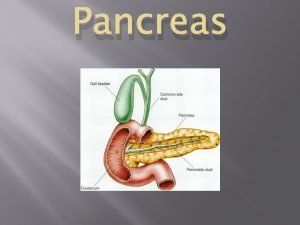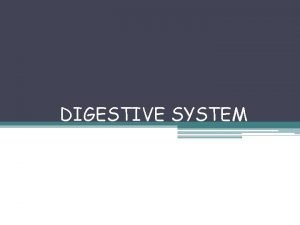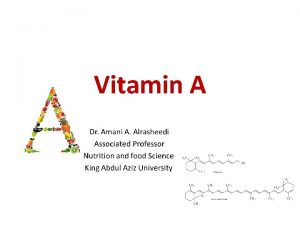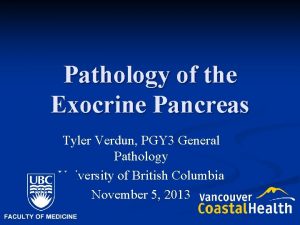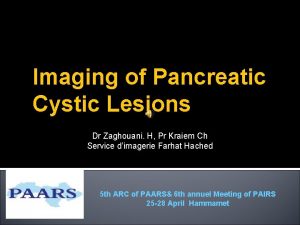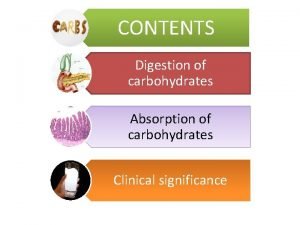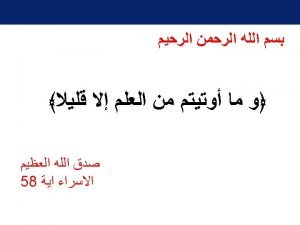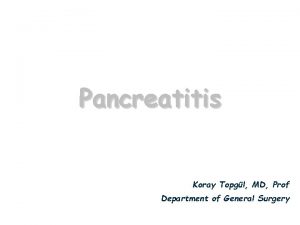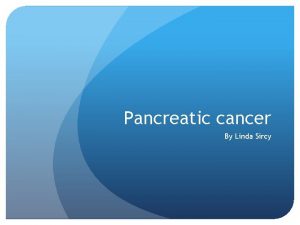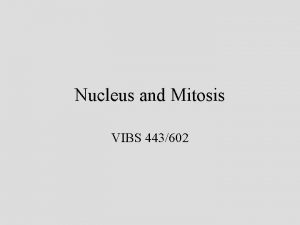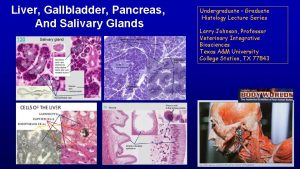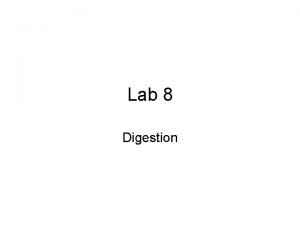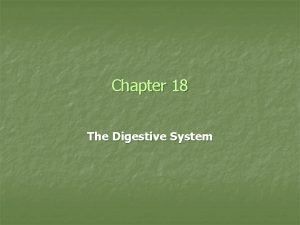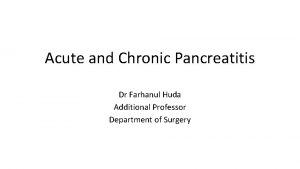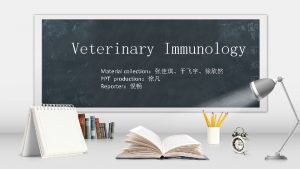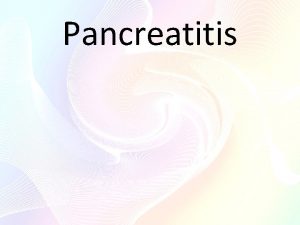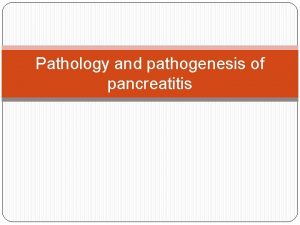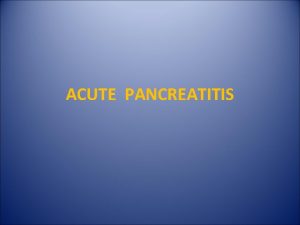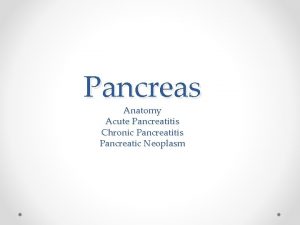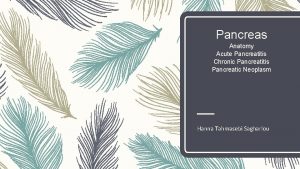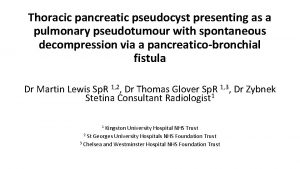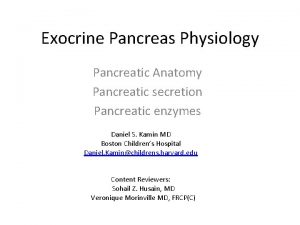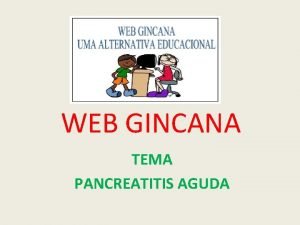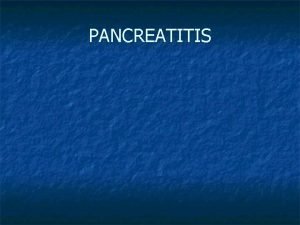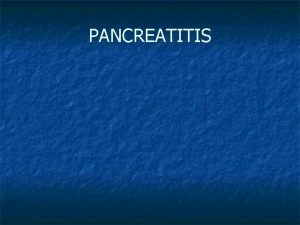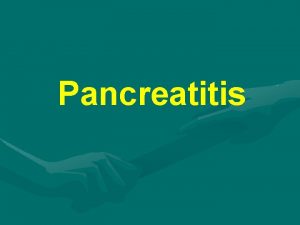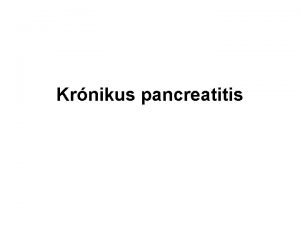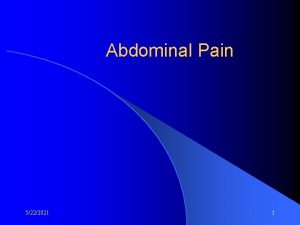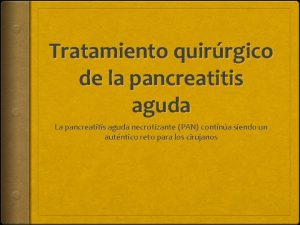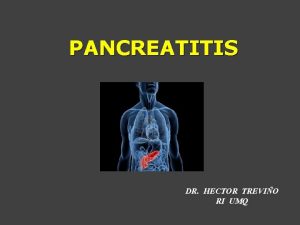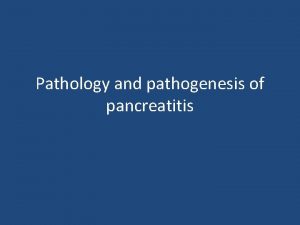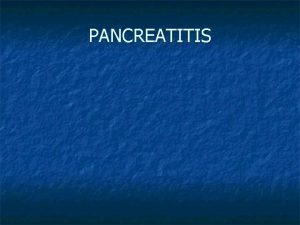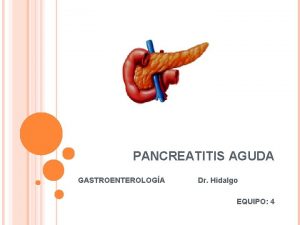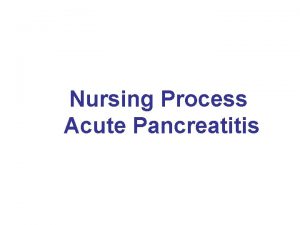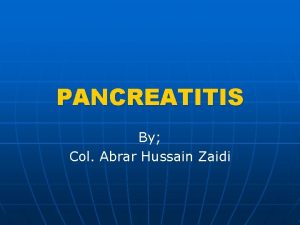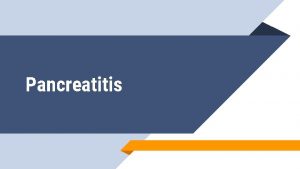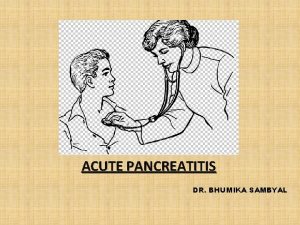Nutritional Management of Pancreatitis Pancreatic Pseudocyst JENNIFER TROST
























- Slides: 24

Nutritional Management of Pancreatitis & Pancreatic Pseudocyst JENNIFER TROST CASE REPORT ARAMARK DIETETIC INTERN 3/10/2016

Pancreas What is the Pancreas? � Organ located behind the stomach � Produces enzymes required to digest food � Produces hormones insulin and glucagon http: //bing. com/images

Disease Description Pancreatitis � Inflammation of the pancreas � Acute or chronic � Etiologies: Chronic alcoholism, biliary tract disease, hypertriglyceridemia, certain drugs, some viral infections, trauma, gallstones � Clinical symptoms: Abdominal pain and distension, nausea, vomiting, steatorrhea � Tests: Secretin stimulation test, glucose tolerance test and 72 hour stool test � Comorbidities: Pancreatic ascites, pancreatic abscess, pancreatic pseudocyst Mahan, LK, Escott-Stump, S, Raymond, JL, Krause, MV. Krause's food & the nutrition care process. St. Louis, MO: Elsevier/Saunders; 2012.

Normal vs. Inflamed Pancreas http: //bing. com/images

Disease Description Pancreatic Pseudocyst � Fluid-filled sac in the abdomen � Often develops after an episode of severe, acute pancreatitis � May also occur in someone with chronic pancreatitis � Cyst occurs when the ducts in the pancreas are damaged by the inflammation or swelling that occurs during pancreatitis National Institutes of Health. US National Library of Medicine Website. https: //www. nlm. nih. gov/medlineplus/ency/article/000272. htm. Accessed March 6, 2016.

Case Presentation �Sixty-one year old male admitted for abdominal pain �History of pancreatitis with pancreatic pseudocyst + abdominal pain, splenic vein thrombosis, streptococcal meningitis, gout, hypertension, HIV, right lower lung pulmonary nodule, deep vein thrombosis �Last seen, December, 2015, for abdominal pain, nausea/vomiting, started on Total Parenteral Nutrition (TPN). Nutrition support in patients with pancreatitis has been shown to play an important role in preventing complications and promoting recovery Siow, E. Enteral versus Parenteral Nutrition for Acute Pancreatitis. Critical Care Nurse. 2008; 28(4): 19– 30. Available at: http: //ccn. aacnjournals. org/content/28/4/19. full. Accessed February 19, 2016.

Nutrition Care Process: Assessment Patient History �Two brothers and one sister �Pt denies smoking, drinking alcohol or using illicit drugs �Patient came from home

Nutrition Care Process: Assessment Food/Nutrition Related History �Diet: Clear liquid diet and cyclic TPN �Medications: Normal saline @75 ml/hour, atovaquone, sliding scale insulin, reglan, protonix, and the following as needed, docusate, dilaudid, zofran

Nutrition Care Process: Assessment Nutrition Focused Physical Findings �Persistent vomiting, unable to keep food down �Decreased appetite �No history of difficulty with chewing or swallowing

Nutrition Care Process: Assessment Anthropometric measurements �Weight, 1/18/16: 93. 6 kg, Height, 181 cm, Body Mass Index, 28. 6 (overweight) �Weight history, last admission: 12/15: 104. 3 kg 11/15: 111. 1 kg �Significant weight loss over 2 month period: 17%

Nutrition Care Process: Assessment Biomedical Data, Medical Tests, and Procedures �Labs January 18 th: glucose (126, high), triglycerides (291, high)

Nutrition Care Process: Assessment Nutrient Needs �Mifflin St. Jeor equation, high accuracy in determining the resting energy expenditure in both normal and obese people �Activity Factor used: 1. 2 -1. 3 �Protein: 1. 5 -1. 8 grams per kilogram �Fluid: 25 ml/kg �Estimated Energy Needs: 2130 -2308 kcal/day, 110 -131 grams protein/day, 2350 ml fluid/day Mahan, LK, Escott-Stump, S, Raymond, JL, Krause, MV. Krause's food & the nutrition care process. St. Louis, MO: Elsevier/Saunders; 2012.

Nutrition Care Process: Assessment Aramark Nutrition Care Level �Identified nutrition care level, 3, based on nothing by mouth (NPO)/Clear Liquid Diet >4 days, acute pancreatitis, 17% weight loss over 2 month period, TPN Malnutrition Identification �Nutrition Focused Physical Exam, deferred as a result of patient’s extreme nausea

Nutrition Care Process: Diagnosis PES Statement �Altered GI Function as evidenced by pancreatic pseudocyst as related to nothing by mouth (NPO), TPN dependent �Diagnosis: Altered GI Function NC 1. 4 �Etiology: Pancreatic Pseudocyst �Signs/Symptoms: Nothing by Mouth (NPO), TPN Dependent Nutritional Intervention �TPN@ 90 ml/hour x 1 hour, then 180 ml/hour x 10 hours, then 90 ml/hour x 1 hour, with lipids twice weekly

Nutrition Care Process: Monitoring and Evaluation January 20 th �With Lantus, blood glucose increased during TPN cycle �Hyperglycemia (1/20, glucose: 611) related to TPN and pancreatitis/pseudocyst, no history of diabetes �Fingersticks: 295, 323, 370, 575, >600 �Plan: infuse TPN formula over 24 hours to decrease final dextrose concentration �Lantus dose increased, sliding scale insulin changed to highest dose

Nutrition Care Process: Interventions Medical Interventions �Surgical cystogastrostomy (drainage of pancreatic pseudocyst) and cholecystectomy (surgical removal of the gallbladder) performed, 1/21/16. It is recommended that decompression of the pseudocyst take place for patients with symptoms, which can be done by endoscopic or surgical cystogastrostomy. Varadarajulu, S. , Bang, J. , Sutton, B. , Trevino, J. , Christein, O. , & Wilcox, C. M. (2013). Equal Efficacy of Endoscopic and Surgical Cystogastrostomy for Pancreatic Pseudocyst Drainage in a Randomized Trial. Gastroenterology, 145(3). Retrieved February 21, 2016.

Nutrition Care Process: Monitoring and Evaluation January 22 nd �Less than optimal parenteral nutrition (NI 2. 8) related to hyperglycemia and hypertriglyceridemia as evidenced by serum glucose (1/22: 336) and triglyceride level (1/22: 343). �Plan: Add 20 units of insulin to TPN tonight. Serum triglycerides, highly elevated, recheck Monday �Fingersticks: 310, 258, 333, 363 �Monitor: Parenteral nutrition tolerance, lab results, weight, intake and output �Goal: Tolerate parenteral nutrition at goal within 1 -2 days

Nutrition Care Process: Monitoring and Evaluation January 26 th �Less than optimal parenteral nutrition (NI 2. 8) related to hyperglycemia, hypertriglyceridemia as evidenced by serum glucose (1/26: 166) and triglyceride level (1/26: 252) �Fingersticks: 174, 149, 186, 229, 116 �Plan: Continue with current nutritional plan. �Monitor Patient: Parenteral nutrition tolerance, lab results, weight, intake and output

Nutrition Care Process: Monitoring and Evaluation January 27 th �Plan: TPN rate decreased to 50 ml/hour on 1/27/16. TPN provides 165 grams carbohydrate, 893 calories, 65 grams protein meeting 42% of patients calorie needs and 50% of patients protein needs

Nutrition Care Process: Monitoring and Evaluation January 29 th � Inadequate oral intake (NI 2. 1) as related to decreased appetite as evidenced by hiccups and reported by mouth (PO) intake. � Continue TPN until PO (by mouth) intake improves, add Ensure Complete nutritional supplement twice a day to provide 350 calories and 13 grams of protein daily. Nutrition Management recommendations for pancreatitis include increased calories and adequate protein intake. � Monitor patient: Diet tolerance, supplement tolerance, parenteral nutrition tolerance, lab results, weight, intake and output. � Goal: Increase oral intake to 50 -75% of meals/supplements within 3 days Mahan, LK, Escott-Stump, S, Raymond, JL, Krause, MV. Krause's food & the nutrition care process. St. Louis, MO: Elsevier/Saunders; 2012.

Nutrition Care Process: Monitoring and Evaluation January 30 th � Plan: Discontinue TPN, monitor diet tolerance Recommend carbohydrate controlled, low residue diet (limits fat and fiber). Nutrition management recommendations include a low-fat diet, with easily digestible foods. � Patient ate a little breakfast without taking Zofran, drinking Ensure Complete. � Inadequate oral intake (N 1 2. 1) as related to decreased appetite as evidenced by hiccups and reported by mouth (PO) intake. � Monitor patient: Diet tolerance, supplement tolerance, parenteral nutrition tolerance, lab results, weight, intake and output � Goal: Increase oral intake to 50 -75% of meals/supplements within 3 days Mahan, LK, Escott-Stump, S, Raymond, JL, Krause, MV. Krause's food & the nutrition care process. St. Louis, MO: Elsevier/Saunders; 2012.

Nutrition Care Process: Monitoring and Evaluation �Patient discharged on 2/3/16 to subacute/skilled nursing facility, Genesis Patapsco Valley Center �Patient continued to have the hiccups and was eating a little at each meal at the time of discharge and was expected to follow-up with his physicians

Research � Pancreatitis Etiologies: Chronic alcoholism, biliary tract disease, hypertriglyceridemia, certain drugs, some viral infections, trauma, gallstones Association between Antiretroviral Drugs (HAART meds) and Acute Pancreatitis in HIV/AIDS patients � Antiretroviral drugs are effective but toxicity can lead to drug-induced pancreatitis � Commonalities among HIV-positive patients that develop acute pancreatitis: non-white race*, advanced age*, long duration of seropositivity, CD 4<2000 cells/mm 3, AIDS diagnosis, high viral load, previous history of acute pancreatitis*, hepatobiliary diseases, opportunistic infection prophylaxis*, alcohol abuse � Antiretroviral drug-induced pancreatitis should always be considered in the diagnosis of patients with abdominal pain and elevated pancreatic enzymes � More evidence needed to determine if pancreatic morbidity is directly related to drugs used in HAART (highly active anti-retroviral therapy) or to other comorbidities *Patient meets this criteria Oliveira N, Ferreira F, Yonamine R, Chehter E. Antiretroviral drugs and acute pancreatitis in HIV/AIDS patients: is there any association? A literature review. Einstein (São Paulo). 2014; 12(1): 112 -119. http: //www-ncbi-nlm-nih-gov. ezp. welch. jhmi. edu/pubmed/24728257

References 1. Mahan, LK, Escott-Stump, S, Raymond, JL, Krause, MV. Krause's food & the nutrition care process. St. Louis, MO: Elsevier/Saunders; 2012. 2. National Institutes of Health. US National Library of Medicine Website. https: //www. nlm. nih. gov/medlineplus/ency/article/000272. htm. Accessed March 6, 2016. 3. Oliveira N, Ferreira F, Yonamine R, Chehter E. Antiretroviral drugs and acute pancreatitis in HIV/AIDS patients: is there any association? A literature review. Einstein (São Paulo). 2014; 12(1): 112 -119. http: //www-ncbi-nlm-nihgov. ezp. welch. jhmi. edu/pubmed/24728257 4. Powerchart. Northwest Hospital. Accessed January 20, 2016. 5. Siow, E. Enteral versus Parenteral Nutrition for Acute Pancreatitis. Critical Care Nurse. 2008; 28(4): 19– 30. Available at: http: //ccn. aacnjournals. org/content/28/4/19. full. Accessed February 19, 2016. 6. Varadarajulu, S. , Bang, J. , Sutton, B. , Trevino, J. , Christein, O. , & Wilcox, C. M. (2013). Equal Efficacy of Endoscopic and Surgical Cystogastrostomy for Pancreatic Pseudocyst Drainage in a Randomized Trial. Gastroenterology, 145(3). Retrieved February 21, 2016.
 Pes statement for acute pancreatitis
Pes statement for acute pancreatitis Allomorphic variation
Allomorphic variation Trost von gott
Trost von gott Tröst çeşitleri
Tröst çeşitleri Nutritional management of diabetes mellitus
Nutritional management of diabetes mellitus Acute pancreatitis nursing management
Acute pancreatitis nursing management Bile and pancreatic juices are secreted in the
Bile and pancreatic juices are secreted in the Pancreas acts as
Pancreas acts as Pancreas funzione
Pancreas funzione Food digestion time chart
Food digestion time chart Role of vitamin a
Role of vitamin a Radiologix verdun
Radiologix verdun Daughter mother grandmother pancreatic lesions
Daughter mother grandmother pancreatic lesions Content of pancreatic juice
Content of pancreatic juice Carbohydrates
Carbohydrates Pancreatic juice
Pancreatic juice Ranson score
Ranson score Stage 2b pancreatic cancer
Stage 2b pancreatic cancer Pancreatic histology
Pancreatic histology Cells
Cells Pancreatic tissue
Pancreatic tissue Function of ruminant stomach
Function of ruminant stomach Pancreatic calcification
Pancreatic calcification Ralph steinman pancreatic cancer
Ralph steinman pancreatic cancer Haustra xray
Haustra xray
